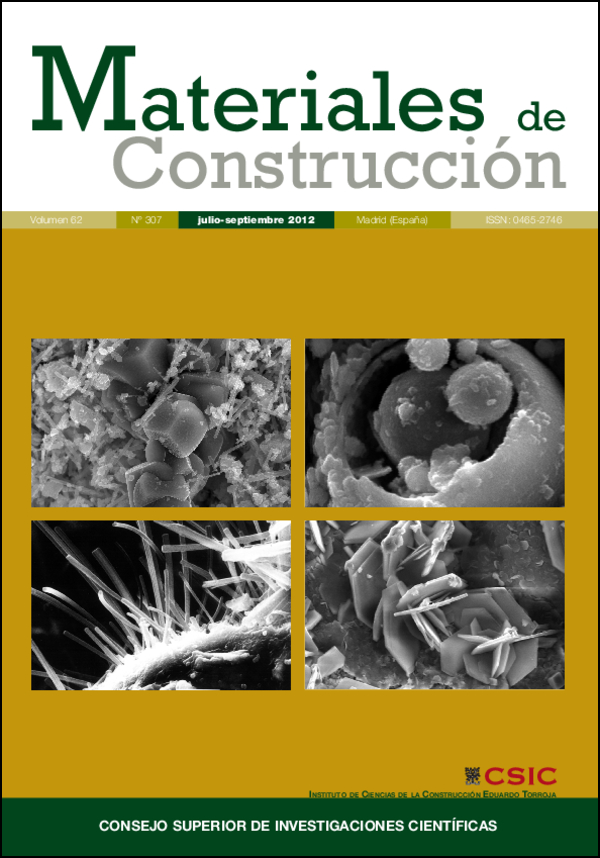Assessing the influence of surface roughness on the epilithic colonisation of limestones by non-contact techniques
DOI:
https://doi.org/10.3989/mc.2012.64410Keywords:
stone, surface roughness, ephilitic colonisation, non-destructive techniquesAbstract
The importance of stone colonisation by microorganisms has led to an extensive literature on mechanisms and rates of physicochemical degradation of stone surface, both in laboratory and field contexts. Biological colonisation of a stone surface depends on intrinsic stone parameters like mineral composition, texture, porosity, and permeability, as well as on environmental parameters. In the present study, quantification of stone surface roughness and its relationship to epilithic colonisation was demonstrated for three types of limestones throughout non-destructive techniques, namely optical surface roughness instrument and digital image analysis. According to the roughness average (Ra) and mean roughness depth (Rz) determined for Ançã limestone, Lioz limestone and Lecce stone, it can be concluded that great surface roughness stones render them prone to microbial colonisation.
Downloads
References
(1) Guillitte, O.: “Bioreceptivity: “A new concept for building ecology studies”, Sci. Total Environ., vol. 167 (1995), pp. 215-220. http://dx.doi.org/10.1016/0048-9697(95)04582-L
(2) Bellinzoni, A. M.; Caneva, G.; Ricci, S.: “Ecological trends in travertine colonisation by pioneer algae and plant communities”, Int. Biodet. Biodegr., vol. 51 (2003), pp. 203-210. http://dx.doi.org/10.1016/S0964-8305(02)00172-5
(3) Gorbushina, A. A.: “Life on the rocks”, Environ. Microbiol., vol. 9 (2007), pp. 1613-1631. http://dx.doi.org/10.1111/j.1462-2920.2007.01301.x PMid :17564597
(4) Guillitte, O.; Dreesen, R.: “Laboratory chamber studies and petrographical analysis as bioreceptivity assessment tools of building materials”, Sci. Total Environ., vol. 167 (1995), 365-374. http://dx.doi.org/10.1016/0048-9697(95)04596-S
(5) Silva, B.; Prieto, B.; Rivas, T.; Sánchez-Biezma, M. J.; Paz, G.; Carhallal, R.: “Rapid biological colonization of a granitic building by lichens”, Int. Biodet. Biodegr., vol. 40 (1997), pp. 263-267. http://dx.doi.org/10.1016/S0964-8305(97)00051-6
(6) Tomaselli, L.; Lamenti, G.; Bosco, M.; Tiano, P.: “Biodiversity of photosynthetic micro-organisms dwelling on stone monuments”, Int. Biodet. Biodegr., vol. 46 (2000), pp. 251-258. http://dx.doi.org/10.1016/S0964-8305(00)00078-0
(7) Prieto, B.; Silva, B.: “Estimation of the potential bioreceptivity of granitic rocks from their intrinsic properties”, Int. Biodet. Biodegr., vol. 56 (2005), pp. 206-215. http://dx.doi.org/10.1016/j.ibiod.2005.08.001
(8) Scardino, A. J.; Guenther, J.; De Nys, R.: “Attachment point theory revisited: the fouling response to a microtextured matrix”, Biofouling, vol. 24 (2008), pp. 45-53. http://dx.doi.org/10.1080/08927010701784391 PMid :18066730
(9) Scardino, A. J.; Harvey, E.; De Nys, R.: “Testing attachment point theory: diatom attachment on microtextured polyimide biomimics”, Biofouling, vol. 22 (2006), pp. 55-60. http://dx.doi.org/10.1080/08927010500506094 PMid :16551561
(10) Alonso, F. J.; Vázquez, P.; Esbert, R.; Ordaz, J.: “Ornamental granite durability: evaluation of damage caused by salt crystallization”, Mater. Construcc., vol. 58 (2008), pp. 191-201.
(11) Hodson, M. E.; Lee, M. R.; Parsons, I.: “Origins of the surface roughness of unweathered alkali feldspar grains”, Geochim. Cosmochim. Acta, vol. 61 (1997), pp. 3885-3896. http://dx.doi.org/10.1016/S0016-7037(97)00197-X
(12) Tiano, P.; Accolla, P.; Tomaselli, L.: “Phototrophic biodeteriogens on lithoid surfaces: An ecological study”, Microb. Ecol., vol. 29, (1995), pp. 299-309. http://dx.doi.org/10.1007/BF00164892
(13) Bergey, E. A.: “Measuring the surface roughness of stream stones”, Hydrobiologia, vol. 563 (2006), pp. 247-252. http://dx.doi.org/10.1007/s10750-006-0016-4
(14) Poon, C. H.; Bhushan, B.: “Comparison of surface roughness measurements by stylus profiler, AFM and non-contact optical profiler”, Wear, vol. 190 (1995), pp. 76-88. http://dx.doi.org/10.1016/0043-1648(95)06697-7
(15) Grissom, C. A.; Charola, A. E.; Wachowiak, M. J.: “Measuring surface roughness on stone: back to basics”, Stud. Conserv.; vol. 45 (2000), pp. 73-84. http://dx.doi.org/10.2307/1506665
(16) Benavente, D.; Martínez-Verdú, F.; Bernabeu, A.; Viqueira, V.; Fort, R.; García del Cura, M. A.; Illueca, C.; Ordóñez, S.: “Influence of surface roughness on color changes in building stones”, Color Res. Appl., vol 28 (2003), pp. 343-351. http://dx.doi.org/10.1002/col.10178
(17) Miller, A. Z.; Leal, N.; Laiz, L.; Rogerio-Candelera, M. A.; Silva, R. J. C.; Dionisio, A.; Macedo, M. F.; Saiz-Jiménez, C.: “Primary bioreceptivity of limestones used in Southern Europe monuments”, in B. J. Smith, M. Gómez-Heras, H. A. Viles, J. Cassar (eds.), Limestone in the Built Environment: Present Day Challenges for the Preservation of the Past (2010), Geological Society Special Publications, London, vol. 331, pp. 79-92.
(18) ISO 4287:1984. Surface roughness-terminology: Part 1. Surface and its parameters. International Organization for Standardization.
(19) Mark, R.; Billo, E.: “A stitch in time: Digital panoramas and mosaics”, in Freers, S. M. (ed.), American Indian Rock Art, vol. 25 (1999), pp. 155-168.
(20) Sezgin, M.; Sankur, B.: “Survey over image thresholding techniques and quantitative performance evaluation”, J. Electron. Imaging, vol. 13 (2004), pp. 146-165. http://dx.doi.org/10.1117/1.1631315
(21) Roeselers, G.; Zippel, B.; Staal, M.; Van Loosdrecht, M.; Muyzer, G.: “On the reproducibility of microcosm experiments —Different community composition in parallel phototrophic biofilm microcosms”, FEMS Microbiol. Ecol., vol. 58 (2006), pp. 169-178. http://dx.doi.org/10.1111/j.1574-6941.2006.00172.x PMid :17064259
(22) Donlan, R. M.: “Biofilms: microbial life on surfaces”, Emerg. Infect. Dis., vol. 8 (2002), pp. 881-890. http://dx.doi.org/10.3201/eid0809.020063 PMid :12194761 PMCid:2732559
(23) Morton, L. H. G.; Greenway, D. L. A.; Gaylarde, C. C.; Surman, S. B.: “Consideration of some implications of the resistance of biofilms to biocides”, Int Biodet. Biodegr., vol. 41 (1998), pp. 247-259.
Downloads
Published
How to Cite
Issue
Section
License
Copyright (c) 2012 Consejo Superior de Investigaciones Científicas (CSIC)

This work is licensed under a Creative Commons Attribution 4.0 International License.
© CSIC. Manuscripts published in both the print and online versions of this journal are the property of the Consejo Superior de Investigaciones Científicas, and quoting this source is a requirement for any partial or full reproduction.
All contents of this electronic edition, except where otherwise noted, are distributed under a Creative Commons Attribution 4.0 International (CC BY 4.0) licence. You may read the basic information and the legal text of the licence. The indication of the CC BY 4.0 licence must be expressly stated in this way when necessary.
Self-archiving in repositories, personal webpages or similar, of any version other than the final version of the work produced by the publisher, is not allowed.
















